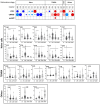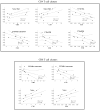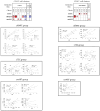T Cell Homeostasis Disturbances in a Cohort of Long-Term Elite Controllers of HIV Infection
- PMID: 38892124
- PMCID: PMC11172696
- DOI: 10.3390/ijms25115937
T Cell Homeostasis Disturbances in a Cohort of Long-Term Elite Controllers of HIV Infection
Abstract
Elite controllers (ECs) are people living with HIV (PLWH) able to control HIV replication without antiretroviral therapy and have been proposed as a model of a functional HIV cure. Much evidence suggests that this spontaneous control of HIV has a cost in terms of T cell homeostasis alterations. We performed a deep phenotypic study to obtain insight into T cell homeostasis disturbances in ECs maintaining long-term virologic and immunologic control of HIV (long-term elite controllers; LTECs). Forty-seven PLWH were included: 22 LTECs, 15 non-controllers under successful antiretroviral therapy (onART), and 10 non-controllers not receiving ART (offART). Twenty uninfected participants (UCs) were included as a reference. T cell homeostasis was analyzed by spectral flow cytometry and data were analyzed using dimensionality reduction and clustering using R software v3.3.2. Dimensionality reduction and clustering yielded 57 and 54 different CD4 and CD8 T cell clusters, respectively. The offART group showed the highest perturbation of T cell homeostasis, with 18 CD4 clusters and 15 CD8 clusters significantly different from those of UCs. Most of these alterations were reverted in the onART group. Interestingly, LTECs presented several disturbances of T cell homeostasis with 15 CD4 clusters and 13 CD8 clusters different from UC. Moreover, there was a specific profile of T cell homeostasis alterations associated with LTECs, characterized by increases in clusters of naïve T cells, increases in clusters of non-senescent effector CD8 cells, and increases in clusters of central memory CD4 cells. These results demonstrate that, compared to ART-mediated control of HIV, the spontaneous control of HIV is associated with several disturbances in CD4 and CD8 T cell homeostasis. These alterations could be related to the existence of a potent and efficient virus-specific T cell response, and to the ability to halt disease progression by maintaining an adequate pool of CD4 T cells.
Keywords: HIV control; T cell homeostasis; immunology; long-term elite controllers (LTECs).
Conflict of interest statement
Author José M. Ligos was employed by Cytek Biosciences. The remaining authors declare that the research was conducted in the absence of any commercial or financial relationships that could be construed as a potential conflict of interest.
Figures




Similar articles
-
Long-Term Elite Controllers of HIV-1 Infection Exhibit a Deep Perturbation of Monocyte Homeostasis.Int J Mol Sci. 2025 Apr 22;26(9):3926. doi: 10.3390/ijms26093926. Int J Mol Sci. 2025. PMID: 40362169 Free PMC article.
-
A specific natural killer cells phenotypic signature associated to long term elite control of HIV infection.J Med Virol. 2024 May;96(5):e29646. doi: 10.1002/jmv.29646. J Med Virol. 2024. PMID: 38699988
-
Infrequent recovery of HIV from but robust exogenous infection of activated CD4(+) T cells in HIV elite controllers.Clin Infect Dis. 2010 Jul 15;51(2):233-8. doi: 10.1086/653677. Clin Infect Dis. 2010. PMID: 20550452 Free PMC article.
-
Elite controllers: A heterogeneous group of HIV-infected patients.Virulence. 2020 Dec;11(1):889-897. doi: 10.1080/21505594.2020.1788887. Virulence. 2020. PMID: 32698654 Free PMC article. Review.
-
Post-Treatment Controllers: Role in HIV "Cure" Research.Curr HIV/AIDS Rep. 2016 Feb;13(1):1-9. doi: 10.1007/s11904-016-0296-x. Curr HIV/AIDS Rep. 2016. PMID: 26781112 Review.
Cited by
-
Persistent elite controllers as the key model to identify permanent HIV remission.Curr Opin HIV AIDS. 2025 Mar 1;20(2):165-171. doi: 10.1097/COH.0000000000000907. Epub 2025 Jan 17. Curr Opin HIV AIDS. 2025. PMID: 39773856 Free PMC article. Review.
References
-
- Betts M.R., Nason M.C., West S.M., De Rosa S.C., Migueles S.A., Abraham J., Lederman M.M., Benito J.M., Goepfert P.A., Connors M., et al. HIV nonprogressors preferentially maintain highly functional HIV-specific CD8+ T cells. Blood. 2006;107:4781–4789. doi: 10.1182/blood-2005-12-4818. - DOI - PMC - PubMed
-
- Ndhlovu Z.M., Stampouloglou E., Cesa K., Mavrothalassitis O., Alvino D.M., Li J.Z., Wilton S., Karel D., Piechocka-Trocha A., Chen H., et al. The Breadth of Expandable Memory CD8+ T Cells Inversely Correlates with Residual Viral Loads in HIV Elite Controllers. J. Virol. 2015;89:10735–10747. doi: 10.1128/JVI.01527-15. - DOI - PMC - PubMed
MeSH terms
LinkOut - more resources
Full Text Sources
Medical
Research Materials

